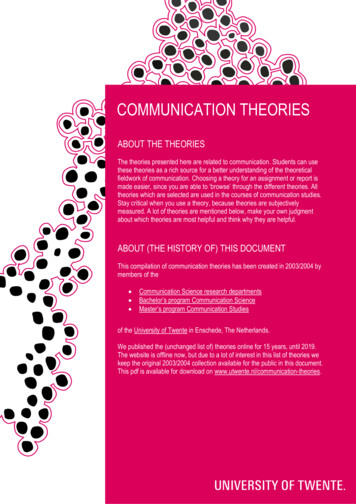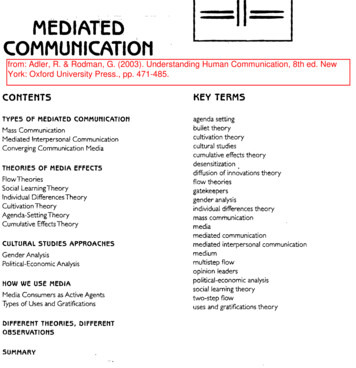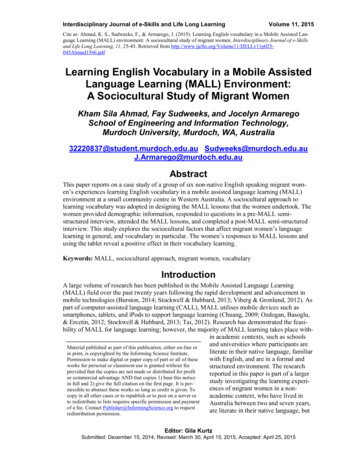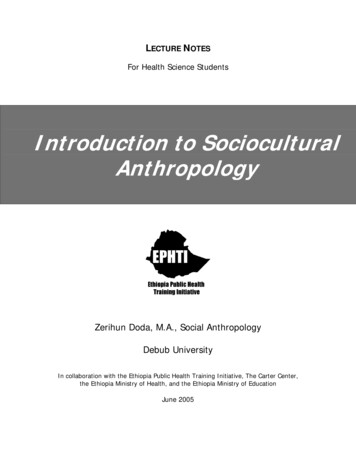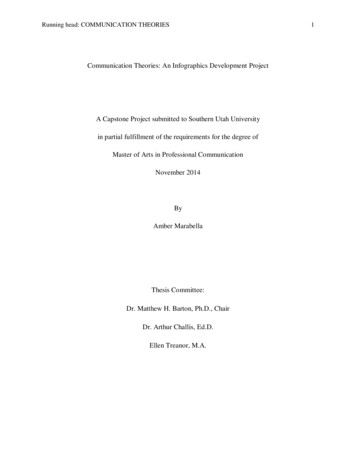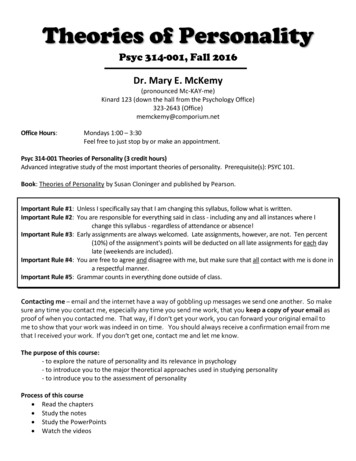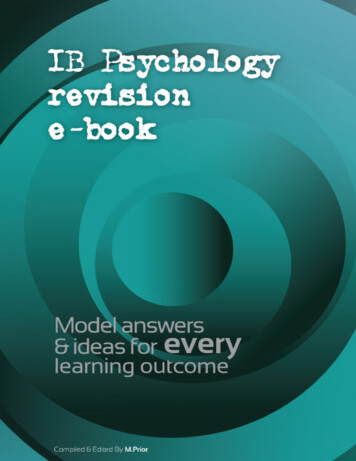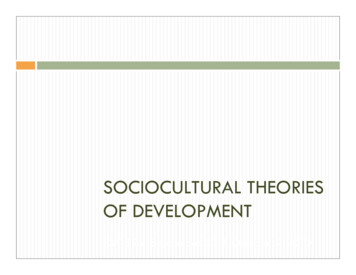
Transcription
SOCIOCULTURAL THEORIESOF DEVELOPMENTPSY 325 September 30 & October 5, 2010
Sociocultural Theories of DevelopmentResearch Investigates how social factors influencecognition and development, and how social andcultural practices shape and define thoughtVygotsky founding father
Lev Semenovich Vygotsky1896 Born in Russia1924 – 34 produced seminal worksincluding Language and Thought. Schoolof Psychology created based on hiswork.1934 died of tuberculosis at age 37.1930s to 1950s work of Vygotskianschools supressed under Stalin.1960s work reappeared, translated
Vygostky’s BeliefsPeople are eager to help children learnnew skills needed to live in their cultureThere are differences in children due totheir circumstances – time, cultureHigher psychological processesdistinguished humans from other animalsand that these processes had theirorigins in social interactions.attention, perception, memory reasoning and concept formation
Vygotsky vs. PiagetPiagetChild as a scientiststrying to understandthe world largely ontheir own.Similarities amongchildrenVygotskyChildren learning in asocial context throughinteraction with others.Differences in childrendue to context.
Vygotsky & PiagetVideo ClipPiaget & Vygotsky in 90 Secondshttp://www.youtube.com/watch?v yYSXM8f0gU&feature related
Central ThemesCognitive development occurs in social interactionPsychological functioning is mediated by languageand other cultural toolsCultural norms and other people influence children’sopportunities for learningSocial and cultural learning require particularcognitive abilities
Theme 1:Cognitive Development Occurs in Social InteractionInteraction with others has a profound effect onhow children developCaregivers, siblings, extended family members,neighbors, teachers, and peers
Theme 1:Cognitive Development Occurs in Social InteractionPiaget – (Individual child as unit of analysis)Acknowledged that children learned throughpeers – more likely to promote disequilibriumBelieved children were more critical of agematched peers.Difference is that Piaget saw the outsideenvironment as giving child information aboutdevelopmentVygotsky (child in context as unit of analysis)saw the outside environment as shapingdevelopment.
Theme 1:Cognitive Development Occurs in Social InteractionInternalization of Socially Shared ProcessesIntermental level – between people who are involved inthe social interaction Intramental level – within the individual Example: infant pointing 1st tries to reach object unsuccessfullyAdult – “you’re looking at this?” (intermental)Child develops ideas of pointing as communication (intramental)Example: Learning to tie Shoes Intermental: adult giving step by step instructionsIntramental: child can do without adults help
Theme 1:Cognitive Development Occurs in Social InteractionZone of Proximal Development Defined as the distance between what a child can doindependently, and what the child can do in interaction with anadult or more advanced peer.Children can reason in more complex ways or perform morecomplex behaviors when they receive assistance than they can doon their own.Examples CountingMath problem (child can do simple arithmetic on own, but withteacher can learn to solve problem together, and later internalizesolution).Important to assess both what child can do independently andwhat child can do with assistance
Theme 1:Cognitive Development Occurs in Social Interaction
Theme 1:Cognitive Development Occurs in Social InteractionVideo ClipVygotsky’s Developmental Theory: An Introduction4:01 minhttp://video.google.com/videoplay?docid 634376752589779456#
Theme 2: Psychological functioning is mediated bylanguage and other cultural toolsTechnical Tools – tools for acting on the environment (i.e. –plows, hammers, silverware) Psychological Tools – tools for thinking – influence the way weorganize and remember information Language – used for regulating behavior, planning, remembering,solving problemsMapsDiagramsNumber systemsAlgebraic symbolsProgramming languagesSystems for conceptualizing dates and time (calendars, clocks)Alphabet songTools for solving mathematical problems
Theme 2: Psychological functioning is mediated bylanguage and other cultural toolsExample of impact of psychological toolsAbacus – 11 year old Taiwanese childrenmade mistakes in mental arithmeticsuggesting that they were thinking aboutsolving the problem on an abacus. Thisillustrates a cultural tool difference, since EastAsian children are likely to learn math usingan abacus, whereas their North Americancounterparts are not. Because of the calculator, less emphasis isplaced on math
Theme 3: Cultural norms and other peopleinfluence children’s opportunities for learning Examples Education:availability of formal education,whether or not mandatory (how would theUS be different if formal education was notreadily available? mandatory?) Infant care practices Child care arrangements Expectations about work, study, play
Theme 3: Cultural norms and other people influencechildren’s opportunities for learning Girl Scout Cookie Example – Learning occurs through directinteraction with troop leaders, parentscustomers, and other children Tools – color coded order forms Specific skills – marketing, math Values – responsibility, courtesy,efficiency, precision, promptness
Theme 3: Cultural norms and other people influencechildren’s opportunities for learningStudy comparing industrialized societies where allchildren receive formal schooling found variations inchildren’s typical activities. Play most common activity in all four cities, but levels of playvaried. Korean children spent the most time playing, Russianchildren the least.Russian and Estonian children spent more time in lessons and workthan US and Korean childrenKorean children spent less time in conversation than the otherthree groups of childrenSystematic differences between middle-class and working-classfamilies Middle-class spent more time in lessons and conversationWorking-class spent more time in play
Theme 4: Social and Cultural Learning RequireParticular Cognitive AbilitiesIntersubjectivityThe shared understanding between people that emergesthrough processes of mutual attention and communication. Contingent Interaction – begins at about 2 months of age –reciprocal actions and reactions between infants andcaregivers that resemble the mutual give and take ofconversation Joint Attention – at 9 months infants can readily followadults’ gaze and pointing gestures; both sharing a commonfocus on particular objects or events – this is key tointersubjectivity
Theme 4: Social and Cultural Learning RequireParticular Cognitive AbilitiesTomosello – comparison of humans and non-humanprimatesWhat is crucial in learning from social interaction ishumans’ ability to understand other people as beinglike themselves, having intentions and mental states liketheir own. Identified 3 forms of cultural learning that rely on thisunderstanding Imitative learning Instructional learning Collaborative learning
Theme 4: Social and Cultural Learning RequireParticular Cognitive AbilitiesImitative LearningReproducing another individual’s behavior in order toachieve the same goal Involves understanding the relation between the otherindividual’s behavior and his/her goal Emulation is learning that involves focusing on the endresult of the other individual’s behavior, without anappreciation of the relation between the specificbehavior and the intended goal. Involves only learning about the task Non-human primates emulate rather than imitate
Theme 4: Social and Cultural Learning RequireParticular Cognitive AbilitiesInstructional Learning Involves direct, intentional transmission of informationfrom one individual to another, with the learnerattempting to understand the task or material from theteacher’s point of view.Formal: Lessons as school Informal: Father teaching to cast fishing line Human adults regularly instruct their children, nonhuman primates do not
Theme 4: Social and Cultural Learning RequireParticular Cognitive AbilitiesCollaborative LearningLearning that occurs when multiple individuals engage incooperative, goal-directed problem solving. Differs from imitative and instructive learning in that it is notmerely a transmission of knowledge from one to another,but rather a joint construction of new knowledge. Involves establishing a common goal, sharing responsibilityfor goal-directed actions, and cooperatively carrying outthose actions. These activities require an ability to take theperspective of the other participants in the interaction. Example: building a train track together – likely to be morecomplex when working on it together, each child will learnsomething
Next Section: Modern Empirical Research in theSociocultural TraditionLearning in interaction with adults ScaffoldingLearning in interaction with peersGuided Participation in Cultural ActivitiesLanguage as a Psychological Tool
Sociocultural Research Area 1:Learning in Interaction with Adults: ScaffoldingConstruction scaffold - Temporarystructure that is used to supportworkers and materials highabove the ground as the buildingis being constructed. Provides support for constructionworkersExtends their range of activitiesAllows them to perform tasks thatwould otherwise be impossible.Once the structure of the buildingis complete, the scaffold is nolonger needed.
Sociocultural Research Area 1:Learning in Interaction with Adults: ScaffoldingSocial Scaffold – supports children’s taskperformance, allows them to extend the range oftheir activities and perform tasks that would beimpossible for them to perform alone.Once children can perform the task unaided, thesocial scaffold is no longer necessary.ExamplesLearning to ride a bicycle Puzzle Story Telling video clip
Sociocultural Research Area 1:Learning in Interaction with Adults: ScaffoldingExample: Preschooler able to complete puzzle with Mom.Scene: A mother is assisting her son as he attempts to construct apuzzle depicting a truck. They are using an identical, completedpuzzle as a model, and their goal is to make the child’s puzzlecorrespond to the model. The child repeatedly attempts to placegreen, triangular pieces in the cargo section of the truck, eventhough no such pieces were used in the corresponding part of themodel.Child:Another green one. Where’s the green? (picks up twogreen triangles from the pieces pile without looking atthe model)Mother: Do we find green up here? (points to the model)Child:(looks at the model) This one. (points to an incorrect placeon the model)Mother: I think maybe it’s a leftover? Do you think so?Child:Nods.Mother: Maybe we don’t need the green one, cause there isn’t anygreen one up there, is there. Remember?
Sociocultural Research Area 1:Learning in Interaction with Adults: ScaffoldingStorytelling Example Videoclip
Sociocultural Research Area 1:Learning in Interaction with AdultsSensitivity of Adult SupportSimplify steps Adjust directions to match children’s performance Example Mayan mothers – more direct assistance to girlsinexperienced at weaving, more help in more difficultphasesContingent interaction helps children advance their skills One step beyond current skill level is best
Sociocultural Research Area 1:Learning in Interaction with AdultsLanguage AcquisitionWhen infants point to objects, mothers say the names ofthe objects. Mothers who give more labels – greatervocabulary. Infants whose mothers also label objects of attention(even when not pointed at) have greater vocabularies Ability to tell coherent, well-constructed stories linked tothe way mothers talk to children Adult support of language in infancy and childhoodalters the course of language development!
Sociocultural Research Area 1:Learning in Interaction with AdultsStudy – children categorizing of itemsAdult provided rationale for category, and asked childto articulate categories Adult provided rationale for category Adult prompted child with lead-in questions Control groups Results – post-test all supported groups got 12-14correct, control group got 5 correct
Sociocultural Research Area 1:Learning in Interaction with AdultsAdults do a better job of scaffolding than peersOutline goals of the task Discuss strategies for meeting the goals Involve learners in making decisions Peers often just demonstrate instead of explaining
Sociocultural Research Area 2:Learning in Interaction with PeersBenefitsCan motivate children to try difficult tasks Provide opportunities to imitate and learn each other’sskills Enable children to fine tune their understanding byexplaining what they know Allow children to participate in discussions that increasetheir understanding
Sociocultural Research Area 2:Learning in Interaction with PeersBut is it effective? Sometimes. Depends on:Age Quality of interaction Relative expertise Task difficulty Cultural norms
Sociocultural Research Area 2:Learning in Interaction with PeersAge Younger children (preschoolers) have trouble workingtogetherLimited ability to ignore distractions Coordinating attention to same aspects of problem Communicating ideas with precision Cooperating Example: Legos, page 122
Sociocultural Research Area 2:Learning in Interaction with PeersQuality of InteractionWorking in collaboration more beneficial Example: 5-Year-Olds in pretend grocery store – pairs whoshared responsibility for route planning did better thanthose who took turns performing the task Siblings offer more explanations and positive feedbackthan same age (of sibling) children. Younger children morelikely to ask for explanations from their siblings. Actively thinking about each other’s ideas is key Combining ideas Identifying strengths and weaknesses in each approach Form a more abstract representation of the problem whenworking in a group
Sociocultural Research Area 2:Learning in Interaction with PeersRelative Expertise Children benefit from interactions with a more skilled or knowledgeablepeer Initial knowledge state 5-year-old Lego example – novices did better with experts than othernovices or aloneEven more skilled peer benefitsMust be ready to learn new ideaExample – fulcrum balance – work with peer did not help children whobelieved that ‘things balance in the center’Same ability matched peers can be helpful “Two wrongs make a right” particularly when the two children have differentwrong views.Conflicting views may be a trigger for knowledge changeWhen both make the same mistake, if feedback is given, they learn from theinteraction
Sociocultural Research Area 2:Learning in Interaction with PeersTask difficultyTask that would be expected to master relatively soon Confidence level important factor Less confident child will be lead by more confident child Confidence can be from being knowledgeable being naïve
Sociocultural Research Area 2:Learning in Interaction with PeersCultural NormsCan influence children’s collaborative style andoutcomes Some cultural values: speed, individual autonomy,cooperation Example: Maze with Navajo and European AmericanChildren
Sociocultural Research Area 3:Guided Participation in Cultural Activities Children’sbehavior is guided by other people Children participate in activities that are routinelypracticed and valued in their cultural communities Important means by which children are socialized into thepractices of the culture in which they develop Refers to both activities in which adults explicitly instructchildren, and those in which children observe andparticipate in routine, everyday activities under theguidance of adults, older siblings, and peers. Examples of activities: dressing, doing household chores,preparing meals, attending religious services More on Guided Participation on Thursday Oct. 7
Sociocultural Research Area 3:Language as a Psychological ToolBelieved to be the most important psychologicaltoolIntegral component of most forms of socialinteraction, including learningPeople use language as a means of regulatingtheir behavior, making plans, solving problemsStructures of language appear to influencehabitual patterns of thought
Sociocultural Research Area 3:Language as a Psychological ToolPrivate speech Children talking out loud to themselves as they play,explore, and solve problems. Example: math problem 17 28, “7 plus 8 is 15, carry the 1,(pause) 2,3,4, so its 45”Vygotsky viewed private speech as manifestation ofchildren’s use of language to regulate their behavior Children use more private speech with more complex tasks Private speech declines over developmental time Eventually becomes inner speech – a silent, internalizeddialogue with the self. Thought becomes internalized language
Sociocultural Research Area 3:Language as a Psychological ToolLanguage and thought are separate until about 2years of age.
Sociocultural Research Area 3:Language as a Psychological ToolRelation between language and thoughtImplication: the language that an individual speaks mayinfluence how that individual thinks Linguistic Relativity Hypothesis – differences in howlanguages encode reality are reflected in paralleldifferences in how speakers of the languages think. Benjamin Lee Whorf “We cut nature up, organize it intoconcepts, and ascribe significances as we do largelybecause we are parties to an agreement to organize it inthis way – an agreement that holds throughout our speechcommunity and is codified in the patterns of our language.”
Sociocultural Research Area 3:Language as a Psychological ToolExample: Study comparing Australian aboriginalspeakers of Guugu Yimithirr language and DutchSpatial information encoded differently Indo-European Languages have terms for orientationrelative to body position (left,right) Guugu Yimithirr only have absolute orientation terms(north, south) Farmer, pig, cow figures presented in first room Did placement in second room depend on language?
Sociocultural Research Area 3:Language as a Psychological ToolExample: Yucatec vs. EnglishYucatec describes objects in terms of material (one longthing wax) English describes objects in terms of shape (one candle) Subjects give a small cardboard box, a small plasticbox, and a flat piece of cardboard Asked, which object is more similar? Study in children indicates language bias emergesat 7-9 years
Sociocultural Research Area 3:Language as a Psychological ToolKorean and English Speaking Toddlers 18 – 23MonthsSpatial relationship differencesEnglish – actions that result in containment (put in, on) Korean – tight fits and loose fits
Theme 4: Social and Cultural Learning Require Particular Cognitive Abilities Tomosello – comparison of humans and non-human primates What is crucial in learning from social interaction is humans’ ability to understand other people as being like themse
